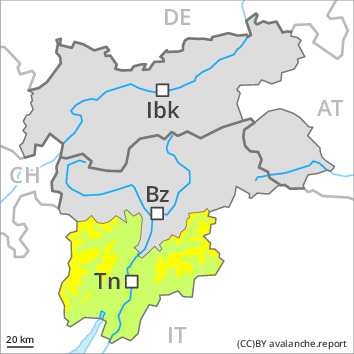
Danger level
 | 2200m |
|  |
|  | ||||
|  |
|  |

Weakly bonded old snow is to be evaluated with care and prudence. Fresh wind slabs are to be avoided.
Avalanches can in some places be released in the weakly bonded old snow by a single winter sport participant, in particular on steep shady slopes at high altitudes and in high Alpine regions, as well as on steep sunny slopes in high Alpine regions. Mostly avalanches are medium-sized. Whumpfing sounds and the formation of shooting cracks when stepping on the snowpack indicate this situation. The number and size of avalanche prone locations will increase with altitude.
The fresh wind slabs are in some cases prone to triggering. Caution is to be exercised on steep shady slopes at high altitudes and in high Alpine regions.
On very steep sunny slopes gliding avalanches and moist snow slides are possible as the day progresses.
Careful route selection is recommended. Steep slopes are to be traversed by snow sport participants one at a time.
Snowpack
dp.7: snow-poor zones in snow-rich surrounding
dp.6: cold, loose snow and wind
Faceted weak layers exist in the centre of the snowpack, in particular on shady slopes above the tree line, as well as on sunny slopes at elevated altitudes. Field observations and snow profiles confirm this situation.
The wind slabs are in some cases still prone to triggering. They are poorly bonded with the old snowpack in particular on shady slopes. As a consequence of mild temperatures and solar radiation the snowpack will consolidate.
Sunshine and high temperatures will give rise as the day progresses to slight moistening of the snowpack. As a consequence of rising temperatures a crust formed on the surface during the last few days.
Tendency
Weakly bonded old snow requires caution. Fresh wind slabs require caution.

